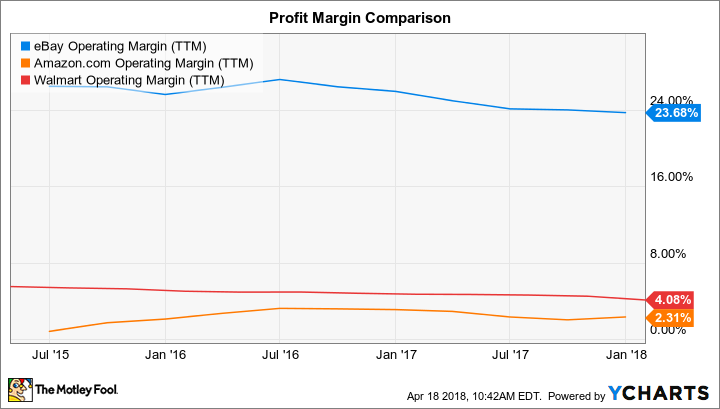What Investors Are Looking for From eBay Next Week
There are many ways to profit from the long-term shift toward e-commerce. eBay's (NASDAQ: EBAY) approach is to create a vibrant marketplace that leaves many capital-intensive parts of the transaction, like inventory management and fulfillment, up to individual sellers.
That strategy tends to deliver market-thumping profitability, and these returns have been even stronger lately as eBay's sales growth accelerates. Investors will be looking for evidence that this positive momentum is intact when the company posts its fiscal 2018 first-quarter results on April 25.
Here are the key trends to watch in that report.
Finding more buyers
Fully integrated e-commerce retailers like Amazon and Walmart are posting sales growth in the 40% to 50% range these days. eBay's gains were 7% last year, which is partly a function of its hands-off approach that just seeks to connect shoppers with sellers.

Image source: Getty Images.
Because sellers tend to follow buyers, eBay's buyer pool is one of the most important metrics to watch. Growth in that category was 4% in 2016 but reached 5% in each of the past four quarters. eBay had a particularly strong holiday season, adding 2 million buyers to its footprint to pass 170 million engaged shoppers.
Another uptick in buyer gains, or at least a steady growth pace, would confirm that the platform is extending its reach. A slowdown, on the other hand, might mean eBay is struggling to drive traffic to its product pages. Alternatively, sluggish buyer gains could mean the platform is failing to get enough of those shoppers to commit to a purchase.
Looking beyond the core marketplace business, investors are hoping to see continued gains in the StubHub segment. The ticket retailer managed double-digit growth last quarter following a 2% uptick in the prior quarter. Another solid increase would suggest that rebound wasn't just a temporary bounce.
Making money
Keep an eye on eBay's take rate, or the percentage fee that the platform charges sellers for its services. That metric ticked down slightly in the marketplace segment last quarter, falling to 7.5% from 7.6% in the year-ago period. But overall the fee was steady for the year, weighing in at 8.4% of gross merchandise volumes.
Healthy volume growth isn't as valuable if eBay has to sacrifice its fees to achieve those gains, and so investors should be looking for the take rate to at least hold steady. That success would translate into slightly higher earnings as profit rises to about $0.53 per share, up from $0.49 per share a year ago.
The 2018 outlook
CEO Devin Wenig and his team issued a 2018 forecast back in late January that predicted a second consecutive year of modestly accelerating growth. Revenue gains should tick up to between 7% and 9%, they said, compared to 7% last year and 5% in the prior year. Executives might update that prediction this week to reflect the latest sales trends and any change in the posture of major rivals like Amazon.
Meanwhile, profitability should decline slightly in 2018, with operating margin hitting 28% compared to 29.5% due to changes eBay is making in its payment processing strategy.
EBAY Operating Margin (TTM) data by YCharts.
That profit margin still trounces the low single-digit rates that Amazon and Wal-Mart generate.
It should also translate into market-thumping financial returns for investors. Free cash flow is likely to be $2.2 billion this year, or about 20% of the $11 billion in revenue that eBay expects to earn in 2018.
More From The Motley Fool
John Mackey, CEO of Whole Foods Market, an Amazon subsidiary, is a member of The Motley Fool's board of directors. Demitrios Kalogeropoulos has no position in any of the stocks mentioned. The Motley Fool owns shares of and recommends Amazon and eBay. The Motley Fool has a disclosure policy.

